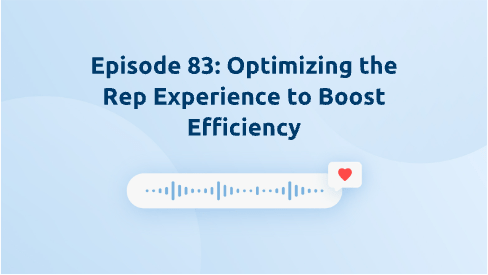When organizations are needing to do more with less, ongoing training of reps is critical to ensure that they have the right knowledge and skills to efficiently achieve success. Research from the American Society for Training and Development found that companies with well-developed training programs report 24% higher profit margins and 218% higher revenue per employee. So, how can organizations ensure that they are leaving no money behind in times of economic uncertainty? Training may be the answer.
Shawnna Sumaoang: Hi and welcome to the Win Win Podcast. I’m your host, Shawnna Sumaoang. Join us as we dive into changing trends in the workplace and how to navigate them successfully.
Here to discuss this topic is Shawn Pillow, the Director of Sales Enablement and Solution Consulting at Granicus. Thanks for joining, Shawn! I’d love for you to tell us about yourself, your background, and your role.
Shawn Pillow: Absolutely. Thank you for having me. By training, I am actually an engineer and an economist, so it’s a little surprising perhaps that I’ve ended up in a role in sales enablement and solution consulting at Granicus. I’ve been here for about six years, and prior to joining Granicus, my specialties have been in operations, go-to-market strategy, and product management. It’s been really interesting to translate those things into the building, deploying, and iterating of training programs for sellers.
SS: I love that and that is such a uniquely blended background. I know that you are also responsible for, as you said, onboarding, training, and upskilling essentially the world-class sales team that is at Granicus. Why is it so critical in today’s sales landscape, and especially amid economic uncertainty, to ensure that you are able to do that for your sales team?
SP: I think it’s really critical as a point for attracting incredible talent to be able to convey to a seller during the interview process, how they’ll be supported, what the organization that is dedicated to making them successful looks like, and how they’ll be able to adapt to uncertainties and certainly the vicissitudes that we see right now in the marketplace. Just as buyers are getting smarter in the sales process, our sellers are getting smarter in the interview process and they’re asking about these things. If you want to deliver a premier training program, you also have to be able to attract premier talent and that starts with being able to tell those sellers how you’ll support them.
SS: Absolutely. I love that. What are some of the unique challenges your reps experience in your industry and how have you seen training and coaching programs help them overcome those challenges to improve their efficiency?
SP: We’re a little bit different in that all of our customers are in the public sector. That could mean the federal government, which is a lot of times what people think about when they think of GovTech, but we also work with special districts and municipal organizations at a really small level. One of the big things that we have to teach our sellers is what those agencies do at a fundamental level. What’s their mission, what outcomes are they trying to achieve, and those vary really widely from one level of government to a level of government, and we just can’t assume that they come in with a baseline understanding of what our customers are trying to do. To be able to empower them to succeed in their initial role, we have to be able to teach them about that agency’s mission and its outcomes. The other challenge is that when our sellers are looking for advancement and they’re looking to progress along their career path, they might move from working with one agency at one level of government to something that’s completely different. We almost have to retrain them about the mission of that agency.
SS: Very interesting. What did your training process look like prior to Highspot and what led to your decision to evolve your investment in Highspot to include training and coaching?
SP: Our previous training process was very one-off in the sense that it wasn’t repeatable, it wasn’t built for operational scale and it sort of started anew every time we onboarded or hired a new seller. Not only does that not make good use of the scarce resources that most enablement teams typically have, but it also meant that we delivered inconsistent results. We built an onboarding playbook alongside an enablement playbook. As we thought about how we institutionalize those things, how do we make sure that we are optimizing for the size of our team and the results that we want and being able to deliver those things in a consistent way so that we can actually measure, iterate and improve, we needed to make an investment in a platform that would let us do that. Because we have been so successful using the content and guidance platform from Highspot, the decision to involve our investment to leverage training and coaching was pretty straightforward.
SS: I love that. Now that you’re using Highspot training and coaching to support your reps, how are you using it to support your reps to drive efficiency?
SP: On the very first day that a seller starts, they get placed into our onboarding program. That takes close to 12 weeks, but one of the things that have been really helpful is the fact that those sellers who want to hit the ground running faster are not just getting exposure to the elements that are part of the onboarding program, they are getting on board into using Highspot as a tool that will be critical for their sales success. What we’re seeing is that just by satisfying the demand that we know exists for training and onboarding during those first 12 weeks, our sellers are actually going above and beyond the content that we’re serving to them and it’s helping them be more successful more quickly.
SS: I love that. Can you share maybe some of the results that you’re seeing from your reps and what the impact has been from having a unified platform to improve sales productivity?
SP: Sure. Our newer sellers are generating substantially more pipeline than people who had previously onboarded have generated. Nearly triple. We’ve been able to reduce their ramp time to productivity by about 20%. As I alluded to before, one of the things that we’re seeing is that by getting exposure to assets during onboarding that they will actually use during their sales process it’s incredibly helpful for them to be able to get that exposure, and because they’re going through a structured onboarding program, we’ve been able to really make additional improvements along the way so that as we evolve our messaging, or as we shift to being more of a platform organization versus a product organization, it’s been really helpful to be able to tweak that to get that messaging into sellers hands sooner during the onboarding process, instead of later. It lets us be much more nimble.
SS: I love that. We had looked into your reps and those that are completing the training and coaching courses and they are essentially driving and generating 3x more pipelines than reps who may not have gone through the course. Can you share tips on how you’re driving the adoption of your courses?
SP: Previously, we didn’t really have a structured onboarding program. As I mentioned, over the summer, we launched that new onboarding program, and using training and coaching was one of the things that we felt was going to be really successful in helping us to do that. As you alluded to, the people who were coming out of onboarding were being more successful and they were being more successful right away.
In addition, because we have our sales managers leaning in to help evaluate their sellers during the onboarding process, they have a really crisp idea when that seller leaves onboarding about where they need to improve going forward. It’s helped them be introspective about where they might like to improve, and it’s helped them be a little bit more critical about the other people on their team and where those people might need additional improvements. Some of the adoptions are coming from the fact that the sellers who have been through the program are some of the most vocal people about the results that the program delivers for them.
I’d say it’s not just about adoption, it’s about helping our frontline sales managers be active in the onboarding process in a way that scales. At the end of the day, they still have a forecast, they have a committed pipeline, they have all of those things and so helping them figure out where they need to be engaged during the onboarding process by having a structured program and courses that go along with that, and then them being able to see the results that they get when a seller successfully completes onboarding leads to sellers who are asking because they didn’t go through a structured process to actually go through some of these courses or to go back and participate in a course again.
SS: I love that because they are so successful having gone through it. They’re proactively seeking it out. I think that’s phenomenal work and it speaks to the tremendous value that you’re bringing to that organization. Now just shift gears ever so slightly, I’d love to understand from you, Shawn, what key metrics are you tracking within Highspot to measure things like efficiency and productivity.
SP: One of my favorite data points to look at is content engagement and content usage. What are our internal consumers looking at and looking at repeatedly? Like what are the types of content? What are the documents? What are the training sessions? What are the presentations that they refer back to most frequently so that we can double down on iterating on those items? Then, what are the items that they’re sending out to customers and prospects on a regular basis that get the most engagement? What are the highest points of leverage that help them move their sales forward? Those things I think are pretty standard.
One of the data points that I look at really frequently is actually the search analytics. What are the things that our sellers are searching for that if we surveyed and asked them, hey, what else should we go build for you? They may not self-report, but that shows up in search data. If we know what types of things they’ll use frequently if we build it and we know what they’re looking for that they may not self-report they need, that really helps us make sure that we’ve got good just-in-time enablement to help them with the most impactful content for the things that they are looking for right now that we may not have.
SS: How are your reps utilizing salesforce integration within Highspot, and does that help you track and improve the efficiency of sales activities?
SP: Definitely helps us track and improve efficiency. We can correlate shared content with wind rates and average sales prices. That’s extremely helpful. I think one of the things that’s the most helpful for our sellers is being able to associate their pitches with accounts and people that are involved in their sales process so that then salesforce actually does become that single source of truth for them, or if they begin working with a new customer or they have a customer that they engaged with two years ago and haven’t really had much interaction with since, they can get a really rich history of areas of interest, engagement with specific pieces of content and then be targeted in the way that they reach out to them in the future for additional communications.
SS: I love that. Last question for you, Shawn. I’d love to hear how you plan to continue to drive efficiency through training, especially amid the economic uncertainty in the months ahead.
SP: I think identifying your highest point of leverage is really critical. In a lot of organizations that might mean expanding the size of a particular supporting team and in periods of rampant growth, that’s an excellent solution. Right now, I don’t think that’s the solution that a lot of people are looking for. They’re trying to identify a larger number of those leverage points instead of a point with like a really high amount of leverage. Instead of dramatically expanding the size of a supporting function, I think one of the key things that we’re looking to do is identify a larger number of people who can have a greater impact. For most organizations, that means making sure your front-line managers are enabled to intervene in those really small, but critical and meaningful ways on a daily basis.
Whether that’s your sales managers, whether that’s, for me, the manager of my solution consulting team, making sure that those people are empowered and have the items that they need on a daily basis to help their individual contributors, to help their sellers. Your sales managers, your people managers, whoever they are in your business, are always going to be the people who can make the biggest difference on a daily, weekly, and monthly basis and make sure that they’re supported and that they’re empowered and that they are enabled is, I think, one of the ways that we’re going to continue to drive additional efficiency. We feel like we’ve got a really good handle on onboarding and enabling our sellers, and so now it’s really time to focus on our people managers.
SS: I love that, and I think that that is a fantastic approach, Shawn. Thank you so much for joining us today. I really appreciate the time.
SP: Absolutely. Thank you for having me,
SS: To our audience, thank you for listening to this episode of the Win Win podcast. Be sure to tune in next time for more insights on how you can maximize enablement success with Highspot.


